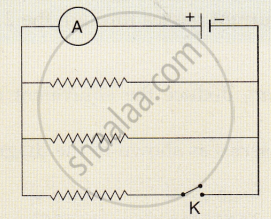Advertisements
Advertisements
प्रश्न
How will you connect three resistors of 2 Ω, 3 Ω and 5 Ω respectively so as to obtain a resultant of 2.5 Ω? Draw the diagram to show the arrangement.
उत्तर
To get the resistance of 2.5 Î, we will have to connect the resistors of values 2 Î and 3 Î in series and this arrangement should be connected in parallel with the resistor of value 5 Î.

Resistance 2 Ω and 3 Ω are in series their net resistance is `R=R_1+R_2`
R=2Ω+3Ω
R=5Ω
This 5 Ω resistance is in parallel with another 5 Ω resistance therefore their net resistance is:'
`1/R=1/R_1+1/R_1`
`1/R=1/5+1/5`
1/R=2/5
R=2.5Ω Hence, net resistance of the combination will be 2.5 Ω
APPEARS IN
संबंधित प्रश्न
With a neat labelled diagram and derive the equation for three resistances connected in parallel.
A wire that has resistance R is cut into two equal pieces. The two parts are joined in parallel. What is the resistance of the combination?
A resistor has a resistance of 176 ohms. How many of these resistors should be connected in parallel so that their combination draws a current of 5 amperes from a 220 volt supply line?
In the diagram shown below, the cell and the ammeter both have negligible resistance. The resistor are identical.
Are the lights in your house wired in series?
Calculate the equivalent resistance between the points A and B in Fig. if each resistance is 2·0 Ω.

Tick (✓) the correct choice among the following :
Consider two cases of two parallel current carrying conductors. Current in
th e same direction and currents in th e opposi te directions will produce
Two resistors of resistance 4 Ω and 6 Ω are connected in parallel to a cell to draw 0.5 A current from the cell.
Calculate current in each resistor.
State the S.I. unit of electrical resistance and define it.
The least resistance obtained by using 2 Ω, 4 Ω, 1 Ω and 100 Ω is:
